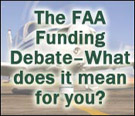28th
November
2010
Back home from the turkey trip — received an email from Aero Sport Power on Thanksgiving that my engine is nearly ready to ship. So, pending the necessary large check, I could have an engine by Christmas. I have zero done (or even parts for) the FWF stuff, so much to be ordered there. (Wonder if I can trade in some Christmas trinkets…)
Today, I read up on drilling the engine mount and did the deed. This wasn’t a big deal at all: I supported the mount with a cargo strap hooked to the center spar, and moved it around until I found the best alignment with the four corner holes. Drilled two to 1/4″ and used some fuel line scraps to make bushings for the AN6 mount holes, then pinned those in place with some long AN4 bolts and drilled the other two holes. I used some long clamps to hold the mount in place while drilling for accuracy, and drilled through a couple more pieces of fuel line. Once the 1/4″ holes were done, I removed each bolt sequentially and enlarged the hole for the AN6 bolt. After the large bolt was inserted, I moved to the next hole. Once the four corner holes were drilled and bolted, the lower inboard holes were drilled, first to 1/4″ then 3/8″. I have the common gap between the mount and the firewall at the lower inboard holes; there are some spacers with 3/8″ holes left over from the fluid fitting bags, which look as though they might work ideally as spacers there.
Once the mount was bolted on, I inserted the nose gear leg and reamed that bolt hole. I did have to scrape off a bit of extra powdercoat from the lower ring of the leg to allow it to insert completely, and polished off the light rust that had formed. Coated the exposed steel with grease for protection.
Finally, pulled the engine mount and gear leg and set it aside again. There’s plenty of holes that need to be made in the firewall before it goes on for good…and more holes to be made after. This is a chicken-and-egg part of the build, where you don’t really want to mount the engine until all (or at least most) of the FW penetrations are made and pieces mounted, but you don’t know for sure where those holes should be until the engine is mounted.
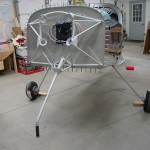
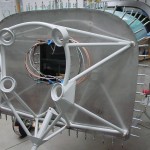
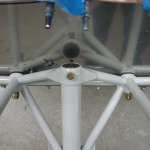
Hours: 2.3 | Posted in Engine |
21st
November
2010
Freezing rain and snow on the way — tonight’s essential task was to get the main gear under the fuselage (Allison’s car needs inside). While this may not be the absolute best way to go — adding the gear lifts the fuselage up quite a ways, meaning any work done over the side will now require a stool — I think it’s the best choice for this project, at this point, since it should let me pretty easily move the fuse around the shop between the “working” configuration and the “parking” configuration.
So, I bolted up the brake brackets and gear legs, omitting the wheel pant brackets for now, as I’ve read they are easy to snag and break while working around the plane. Mounted both tires to the wheels, and put them on the legs with spacers and axle nuts, then removed the sawhorse. I was surprised at how light the tail is in this configuration — will have to remember to be careful loading stuff, including myself, into the cabin, to avoid a nose-ground interface. A sandbag on the aft deck should take care of that issue. I set the tailcone on a caster-base stool, and it’s easy to wheel around the shop, so I’m hoping this will help keep progress going, and a car space open. I’ll have to rework the shop to eliminate some boxes, in order to gain enough length for the engine & mount on the front of the fuse.
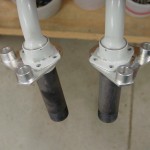
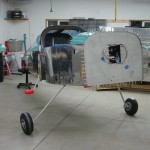
Hours: 2.0 | Posted in Gear & Fairings |
18th
November
2010
Removed the vertical and horizontal stabilizers along with the various spacers and brackets which accompany them, the rudder stops, and fuel tank attach brackets. These all need priming, and having them off will make the winter shop configuration more manageable.
The next step is to get the nose of the fuselage off of the scaffold, since it blocks access to the firewall, which is needed to begin work there (in preparation for the engine). The easiest way to do this, I think, is to put on the gear legs and use a rolling stool under the tail (the plane is tail-heavy without the engine up front). To that end, I started work on assembling the gear legs by finding all the bits and pieces, and monkeying with the brake assemblies to understand how they go together. I polished some light rust off of the axles, then reamed the 5/16″ hole for the bolt which attaches the brake flange. With a light coat of bearing grease, the flanges went on and are now attached. I also have the brake brackets on now, but not bolted, as I need to verify they are in the correct orientation–the C2 plan page references in the manual leaves much to be desired in this area.
Tonight’s research project: wheel assembly. Oh, and I need to pick up some tire talc (aka baby powder?).
Hours: 2.1 | Posted in Gear & Fairings |
15th
November
2010
Finished up the fitting of the right flap with a couple off-on cycles of the flap pushrod to get the exit hole just right. Momentarily hooked up both flaps to actuate them and see if they had correct travel and both retracted flush at the same point. All seems to be well, though the total travel is about half a degree short of 32* — the spec called out is 32-37. I’ll have to check what others have had, but I don’t really see a way to increase the travel–changing the pushrod length seems like it would change the up and down points, while leaving total travel unchanged.
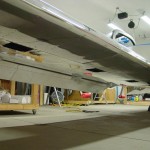
After that was completed, the flaps were removed again, and the wings removed and placed back in the cradle. Flaps and ailerons were put back on for storage–it’s easy to store them there, where they’re less likely to suffer accidental shop damage. Fuselage and work table pushed to opposite sides of the shop to make room for Allison’s car in the middle. It’s not by any means a usable shop to accomplish work in, but hopefully will help keep her happy in the mornings. When the engine arrives, it may need to go in the living room, though…
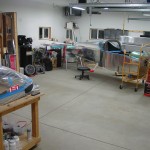
Hours: 1.8 | Posted in Wing & Tail Joins |
14th
November
2010
With the chunk of angle for the replacement fuel tank bracket in hand, it was off to the shop to carve it up. Using the well-fitting left bracket for a template, I traced it in reverse onto the angle for the right bracket, then cut with the bandsaw–bent the angle before cutting the 1″ leg, then shaped to final size with sander and wheel. Clamped both brackets up to the tank and fuselage, and drilled from inside. The bottom hole is easy to drill, but the top hole is blocked by both a gear tower tube and the fuel vent line, which meant that the vent line had to come off, and the angle drill be used to make the hole. No problem; then the brackets are temporarily bolted up and clamped to drill the hole through both brackets. Once the wings come off, the hole will be slotted and a nutplate installed (after priming…).
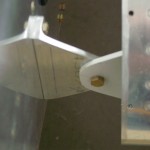
That task complete, on to the final remaining item before wing removal…installation of the flaps and pushrods, which required cutting the pushrod exit holes. I started by enlarging the holes in the side and bottom skins with a unibit to 1/2″, then connecting them in a rough shape with a round file. After the pushrod is attached to the flap and the flap to the wing, the pushrod can be inserted from the bottom and pinned to the actuator arm; then the actuator is moved up and down to check the pushrod hole. It took several rounds of removal, enlargement of the hole (Dremel sanding drums work well), and re-connection before the hole was right. I wanted to creep up on it, so as not to have a larger than necessary hole. Once everything was fitting well, I made a tracing of the hole and transferred that to the other side for a starting point…trimmed it out slightly small to allow for any difference between the sides to be taken up during the fit/enlarge process, but it should make the second side easier. Finished the rough cutting and hooked up the pushrod before calling it a night. Hope to get the flap finished and the wings pulled tomorrow, to gain Allison’s car a space in the garage again.
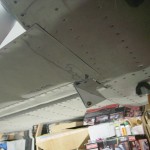
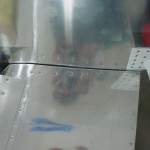
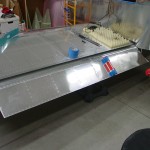
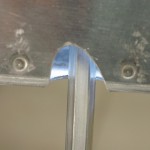


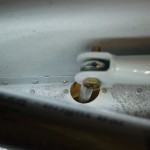
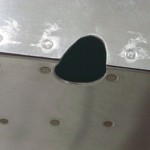
One word of caution and lesson learned: beware of the little flaps of metal that hang off the aft end of the wings at the inboard edge of the flaps. When the flap is attached, this piece tends to end up on top of the flap nose…it must be on the bottom side of the flap, or it will be pushed up between the flap and the rear spar and bent when the flaps are raised. I didn’t check this before raising the left flap, and then promptly repeated the mistake on the right flap…sigh. The bends mostly came out by hand; I’ll work them a bit more when the wings come off. At least they’re symmetrically bent now…keeps the plane flying straight! (builder joke…)
Hours: 3.9 | Posted in Wing & Tail Joins |
10th
November
2010
Lots of work at work, and more work when I come home at night…the only plane progress has been unpacking the replacement angle stock for the tank bracket (along with the 4-channel dimmer I ordered as long as I was paying for shipping). However, I did find a picture of my seat on Classic Aero’s website today…they’ve been posting many recent customer shipments in a gallery to show a broader range of designs, and they took a far better photo than I did. Haven’t sat in them yet, but they sure do look nice:
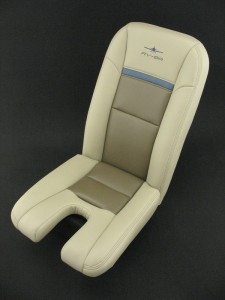
Seat details for future reference:
- Classic Aero Aviator style, “horizontal stripe” design
- Ultraleather fabric
- Papyrus edge color
- Walnut center color
- Diplomat Blue stripe color
- Embroidery matches blue stripe color
- Built-in seat heaters
- Papyrus color stick boots (not shown)
- Front carpet in Latte color (not shown)
- Aileron pushrod boots and glareshield pinch welt (not shown)
Posted in Cabin & Interior |
1st
November
2010
Another attempt to bend the fuel tank attach brackets; clamped the first one tight in the vise using a radiused hardwood block as a sort of mandrel, following the lead of a few who have gone before. Wailed on that sucker with a big hammer and got about half the required bend; further whacking only served to flex it down into the top of the vise and gouge it up. Bugger. Tried soemething different on the second one: used some bits of aluminum angle to fix it in between the vise jaws, with one leg on each jaw, and slowly cranked down. A couple tries had the bend spot on. No more material left that’s big enough to make another bracket to replace the gouged up one, so that’ll have to be ordered from Van’s (this being part of the stuff that holds the wing on…). What’s one more shipping delay, right?
In happier news…the seats arrived this morning! I was almost out the door for work when the UPS truck pulled up, and offloaded a couple big boxes. There they sat while I put in a day’s work, and tonight we popped them out to admire. They turned out nicely, I think. Back in the box for now for safekeeping.
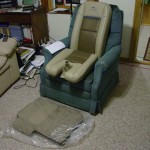
Hours: 1.2 | Posted in Wing & Tail Joins |
30th
October
2010
Attempted to finish up the final tasks around mounting the wings tonight, in an effort to get at least one garage bay open for parking again. First up was drilling the wing root fairings, which turned out to be relatively easy. The fairing is pre-drilled all along it’s length, and the holes match up with open holes in the wing top skin. Once in place, the holes are match-drilled into the edge of the fuel tank skin. Then the bottom fuselage skin is drilled to the wing skin, with the aid of guide lines drawn on the wing skin before mating the wings. I first drilled all the holes to #40, then enlarged to #19 for the #8 screws. Once the wings are removed, these holes will be prepped and nutplates attached.
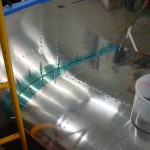
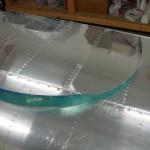
The other remaining task was to fabricate and install the F-996A fuel tank attach brackets, which mate with the beefy angle piece built into the inboard nose of each fuel tank. Cutting and shaping these was straightforward if tedious (due to the 3/16 thickness of the angle), but the bending appears to be the tough part…clamping them in the vise and using a crescent wrench (a la longeron bending) did nothing, nor did whacking them with a hammer and wood block, or attempting to compress them in the vise (as we do in other places when narrowing the spread of a piece of angle). Reading the typical online sources, it appears I just need to hit them harder, so that’ll be tomorrow’s task. Tonight, I’ll double-check that everything is done that needs doing before pulling the wings.
Hours: 3.8 | Posted in Wing & Tail Joins |
24th
October
2010
No work on the project for nearly a month, though it’s been near in thought. Times have been busy at work pushing toward completion of a complete remodel of our audio production studios, and life has happened in other areas, as well. In the meantime, Vertical Power shipped me the new blank box for the VP-X Pro (the other one is on the way back), and I bought some vise-grip clamps for drilling the rear spars. That’s about the entire progress that was made on the project; the upside is that the credit card bill this month will be gloriously small.
Tonight I pushed over the next hurdle, hoping that things will mellow a bit for at least a few weeks and allow some work time…the engine and interior should be coming early next month, and the icy season is dead ahead, so I need to get the wings off and restore some garage parking.
After checking the fuselage for level fore-aft and laterally, I trimmed a block of hardwood to a bit larger than the spacer required for finding the wing incidence, and fine-tuned it’s length with the disc sander. With the block of wood securely taped to a 4′ level at the correct distance from the end, and a bucking bar taped at the far end to hold it on the wing, I was ready. Setting the wing incidence was easy; both were very close to start with, requiring only a small adjustment upward, and a push to be sure the rear spar was fully seated in the “hand” of the fuselage. Clamped down and measured in several locations along the wing, then marked the infamous 5/8″ edge distance on the spar stubs (a piece of scrap filed to 5/8″ made marking easy…I actually cheated for extra safety margin and used a 21/32″ strip, and the width of the marker line made it more like 11/16″…).


Satisfied with the rigging, I test-fit the flaps as suggested by Van’s in their incidence drilling guide. Both flaps required filing off a small portion of the inboard nose skin to clear the spar stub for full retraction, but the bottom skin tucked nicely against the fuselage bottom. Flaps off, I went in and re-read the drilling guide from Van’s. A couple more measurements, and it’s time to get on with the drilling. “Nothin’ to it but to do it,” as they say.
The actual deed was done easily. A long #30 bit and a drill guide made from a block of oak set the pilot holes in the center of the edge-distance box. Stepped up the holes with a series of drills to final size: #30, #20, #10, .250, .295, then the .3115 reamer for final fit on the AN5 bolt. A touch of deburring and in went the bolts. Done.
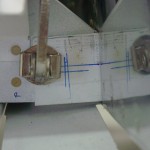
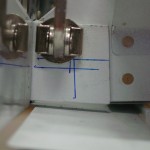
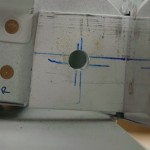


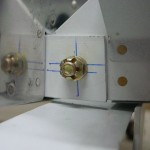
Hours: 2.8 | Posted in Wing & Tail Joins |
26th
September
2010
Hit the major goal for this weekend with a short work session: the wings are attached for the first time. I was able to use a rolling chair with the back removed as a fixture to handle the wings for joining them to the fuselage; along with a sawhorse and a 2×4, it went pretty easily. I ground the threads down on my four hardware-store bolts to use as drift pins, tapping them in with a rubber mallet when the holes were closely aligned. After the first fitting, I had to remove the wings to file a bit off the rear spar stubs to remove a touch of forward sweep. On the second fitting, the forward sweep has been reduced to less than 1/16″ per side…I could call that good, or choose to pull them again and file the stubs some more. I’ll also read through Van’s wing attach guide document once more to be sure of what happens next.
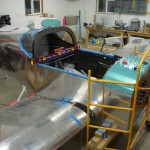
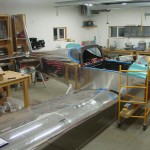
Hours: 2.1 | Posted in Wing & Tail Joins |






























